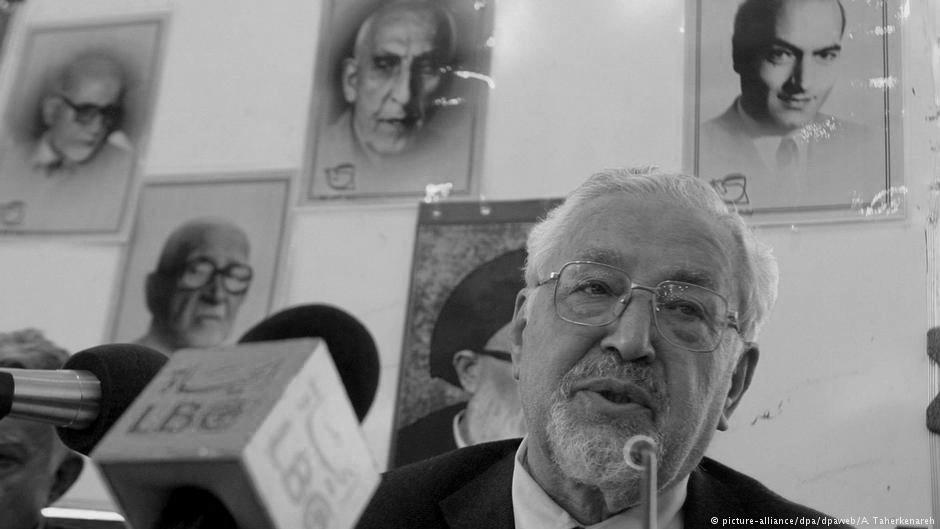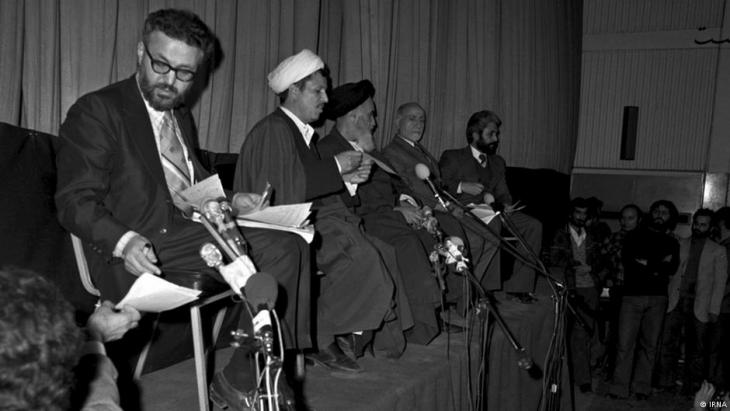An emblematic figure of Iranian politics bows out

An intellectual of serene temperament capable of acute analysis, who was nevertheless destined to remain an outsider. Once an integral member of the most restricted circle of Iranian revolutionary leaders, Yazdi was among those who accompanied Ayatollah Khomeini on his return flight to Iran in February, 1979. He worked to establish the Islamic Republic and went on to serve as its first foreign minister.
Born in 1931 in Qazvin, a city in the north-eastern region of Iran, Ebrahim Yazdi came from a well-to-do family. His formative years took place during the time of Mohammad Mossadegh′s government, the prime minister who had delivered a breath of democratic fresh air to Iran – before being deposed from power by a CIA-backed coup d′etat after having nationalised the oil industry.
Yazdi was studying pharmacology at the time, at the University of Tehran. In 1959 he went on to complete his studies in the United States at Massachusetts Institute of Technology, obtained U.S. citizenship and began working as a doctor. This was where his militant political stance against the Shah′s regime took shape in the 1960s. In 1961 he joined the Freedom Movement for Iran, founded by Mehdi Bazargan. In 1963 he helped establish the Islamic Association of Students in Iran.
Organised opposition to the Shah
Over several years he worked to knit together an international network of contacts which, at the time, also involved organising camps for guerrilla warfare in Egypt and Lebanon. In 1972, Ayatollah Khomeini, who had by then emerged as charismatic leader of the opposition to the Shah (then in exile in Najaf, Iraq), nominated Yazdi as his representative in the U.S.. When, in 1978, Saddam Hussein′s regime forced Khomeini to leave Iraq and he was denied entry into Kuwait, it was Yazdi who hosted him at Neauphle-le-Chateau, on the outskirts of Paris.

During this French exile, Yazdi often acted as spokesman to Khomeini – along with other young western-educated revolutionaries such as Abolhassan Bani Sadr and Ghotbzadeh. He represented the liberal, moderate and constitutional side of a revolution which was inclusive towards all sorts: from the most fundamentalist Islamic factions to the ′Islamic nationalists′ such as Yazdi himself as well as, on the left, the communist party, the liberals, the intellectuals, the enlightened bourgeoisie and the more popular factions. None were excluded. Perhaps those such as Yazdi thought that, following the revolution, Khomeini would have settled for a role as ′spiritual guide′ at his theological seminary in Qom. As we know, this was not to be.
During those first months of 1979, following the Shah′s exile, Ebrahim Yazdi became foreign minister for the first ad interim post-revolution government of which, Mehdi Bazargan, the leader of the Freedom Movement for Iran, was prime minister. At the same time, Bani Sadr became the first president of the Iranian Republic. In those months, whilst the elections for the constitutional assembly (which subsequently laid out the blueprint for the Islamic Republic) were being prepared, Yazdi contributed in the establishment of the Islamic Revolutionary Guard.
Triumph and downfall of the Islamic Revolution
In short: Ebrahim Yazdi was a product of the Islamic Republic – and never ceased to defend it. His involvement in government, however, was to be brief: once the Shah was ousted, it wasn′t long before the more extremist factions took the upper hand (″The power struggle between the various groups and currents broke out at the dawn of the revolution, such is the way of the world,″ Yazdi told me calmly the last time we met, in 2009).
According to him, the downfall began in November 1979, when a group of revolutionary students occupied the U.S. embassy of Tehran, taking 52 Americans hostage. The ′ hostage crisis′ would last 444 days, marking the beginning of the Islamic Republic′s international isolation.

When Khomeini expressed his support for the occupation of the embassy, Bazargan and his government resigned in protest: Yazdi later expressed his conviction that the fall of the ′moderate′ government was actually one of the objectives of the revolutionaries.
In any case, Yazdi would never step foot inside the chambers of power again. In 1980 he was elected as a deputy, but was subsequently banned from putting himself forward for the position. After all this was amongst the most difficult periods in Iran′s history, a time of internal repression and war: in September 1980, the Iraqi army invaded Iran and the defence efforts reunited the country under a common cause – but it also allowed extremist factions to reinforce their hold on the government. It was thus that Bani Sadr, deposed on behalf of a parliamentary vote, was forced into exile.
In 1981, during a series of arrests amongst moderates, including the execution of Foreign Minister Ghotbzadeh, Ebrahim Yazdi accused the Islamic Revolutionary party to have used ″Stalinist and anti-Islamic methods″. In 1983, when Iran succeeded, following strenuous battles, in warding off Iraqi forces at the border, the Freedom Movement pronounced itself against a continuation of hostilities (which, nevertheless, carried on until 1988). For this, the party was ostracised and heavily repressed by the factions who were by then in power. Yazdi himself was arrested multiple times and had his passport confiscated.
Ebrahim Yazdi – the Islamic Republic′s new pariah
In 1990, shortly after the passing of Ayatollah Khomeini, he was denounced as ″footman of the U.S.″. In 1995, following the death of Mehdi Bazargan, he took on the presidency of the Movement for Freedom in Iran – which, by then, was reduced to a mere symbol, at most a movement of opinion, not quite illegal but barely tolerated.[embed:render:embedded:node:17553]Only when reformist president Mohammad Khatami was elected in 1998, inaugurating a period of political and social easing, was Yazdi′s voice publically heard once again. By this point he had long left the political stage, but remained an icon in the eyes of young political reformists as a reference point in the debate regarding Islam, democracy and social transformations.
Nor did he hold himself back: he protested the exclusion of renowned reformists from candidatures, against the recurrent waves of arrests endured by journalists and the opposition, as well as signing various appeals – which often saw him being detained, interrogated and sometimes jailed.
Ebrahim Yazdi was a liberal Muslim, a supporter of democracy who, however, never renounced the Islamic Revolution to which he contributed. The last time I met him was in 2009, shortly after the elections which gave a second (contested) mandate to President Mahmoud Ahmadinejad whilst the Iranian TV was announcing the seven deaths at the end of a manifestation of support for the defeated reformist candidates. According to Yazdi, that protest signalled ″the most serious political crisis experienced by the Islamic Republic in its thirty-year history″.
Yazdi was convinced, however, that the legitimacy of the Islamic Republic was not in question – an opinion shared by many reformists and opponents: ″There′s room for change within the system and all those in opposition, who are now contesting the vote, are loyal to the Islamic Republic. Rather: the constitution has been violated and this undermines the legitimacy of institutions.″
Ebrahim Yazdi was arrested shortly thereafter for ″attempting to convert the government of the velayat-e-faqih (′supremacy of the jurisconsult′, the primacy of the clerics over political power) to a democratic power″. How paradoxical. He was once again condemned in 2011, to an eight year sentence nonetheless, for ′threatening national security′, the standard accusation for any dissidence.
Ebrahim Yazdi died in Turkey at the end of August following a long illness.
Marina Forti
© ResetDoc 2017
Translated by Liam Mac Gregor-Hastie